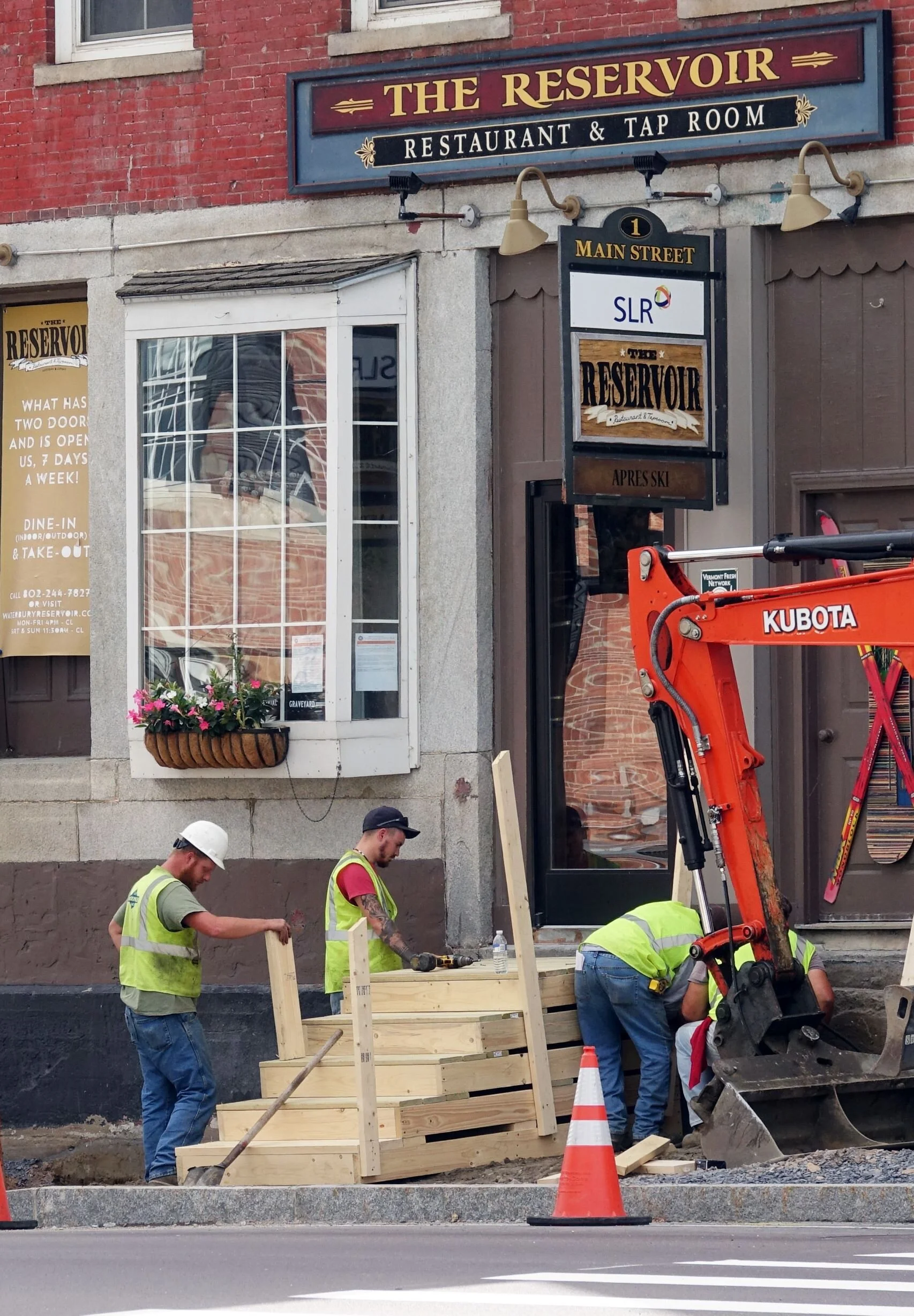Survey says … the public is happy Main Street is finished
Sept. 24, 2021 | By Lisa ScagliottiSunflower Salon & Boutique gets its old steps removed to prepare for a new entry rebuilt as one of the final pieces to the Main Street reconstruction project. Photo by Gordon Miller
With Main Street reconstruction now in the rear-view mirror, a survey earlier this month asked the public to share feedback on how they thought the three-year $21 million undertaking went.
This summer’s work by contractor J.A. McDonald wrapped up the overhaul of about a mile of Waterbury’s Main Street, rebuilding the road, curbs and sidewalks, and along the way replacing decades-old water and sewer lines connecting with every property.
Just a few steps remain for the project to be 100% complete. The process of removing overhead utility lines will be completed next spring and old wooden poles will be removed and the sidewalks patched. Part of the project involved burying underground conduit to carry wires for telephone, power, internet, etc.
Workers construct new temporary wooden steps at the entrance of The Reservoir Restaurant. Photo by Gordon Miller
“Next year when the utility lines all come down, the streetscape should be really beautiful,” said Barb Farr, whose job as transportation liaison for the town came to an end with the completion of the project.
Some construction beside the road remains in progress as contractors work on rebuilding the entry steps to The Reservoir Restaurant and Sunflower Salon at the intersection of Main and Stowe streets. The roadway was widened at that spot and new traffic signals installed. The old steps were too close to the road right of way and new ones are being constructed. Temporary wooden steps have been built and installed to be used in the interim. That project is not expected to affect traffic, Farr said.
A total of 200 people responded to the survey and just over half offered comments at the end. Farr shared the results of the survey with Waterbury Roundabout this week.
Those participating were mostly regular travelers of Main Street with 60% saying they were there daily and another 29% said they were on the street several times a week. Most -- 88% -- said they travel Main Street in the course of their daily routines for work, school, shopping, etc.
Asked how happy they were with the project, 85% said they were either very satisfied (48.5%) or satisfied (36.5%). Another 9% were neutral with 6% either dissatisfied or very dissatisfied.
When asked how satisfied they were that those running and overseeing the project worked to manage the impacts on businesses and residents during construction, 82% were either satisfied or very satisfied; 12% were neutral, leaving just 6% dissatisfied.
People’s impressions of the impact on their daily lives were mostly as expected (39.5%) or better (24%) or somewhat better(17.5%) than expected. Those saying it was somewhat worse or worse than expected totaled 18.5%.
Other questions focused on communications during the project, asking what methods people relied on for information and what they preferred. More than 87% were satisfied or very satisfied with the communication they received; another 8.5% were neutral, leaving just 4% unhappy with communication.
In the comment section, feedback ran the gamut of observations, reactions, and even emotions connected with the extensive project. Comments reflect the degree of transformation the project brought to Main Street with a mixture of praise and criticism and some questions and suggestions.
Many praised the level of communication about the project and efforts of contractors and flaggers to be accommodating.
“I must say that all the workers were friendly and very helpful,” one commenter wrote. “One even let us know that the restaurant we were approaching was not open and what days that they were!”
Others complained about noise, delays and insufficient attention to details at individual properties along the route. “Wasn’t there going to be some services available to home significantly impacted like power washing?” one respondent asked.
Some offered suggestions like adjusting the audio messaging at crosswalks to add the word “walk” instead of just “wait” to help those who are visually impaired.
The sidewalk “bump-outs” at crosswalks drew the most criticism with many questioning their need, their practicality for example with regard to snowplowing, and their safety given that bicyclists need to steer around them getting closer to motor vehicles in the process: “Why do we need the bump outs?” “Not thrilled with the bump outs.” “I feel sorry for the poor guys that are going to have to try to plow snow on this obstacle course.”
Flaggers, J.A. McDonald workers, and Farr herself were on the receiving end of much praise. “Barb Farr rocks logistics!” one wrote. “Flagmen were incredibly respectful and helpful.” And, “The entire McDonalds crew was thoughtful, considerate, careful and truly fun.”
The most-noted shortcoming? Lack of bike lanes in the finished roadway. “The only disappointment is our inability to create a bike lane in a town that is full of bike commuters,” one respondent commented.
“They should have added bicycle lanes (protected or green paint). Feels like a total missed opportunity!” wrote another.
Yet another was more blunt: “Main St is terrible and dangerous for bicycles. I’m very disappointed there is no bike lane or safe travel space for bikes.”
Others managed to express both the strain of the project along with gratitude: “Difficult at times and glad it is over. Looks great!!!”
“I live on North Main St. It’s been hell,” another commented. “But at least I felt like I was in the loop on what was happening. So that was the silver lining. So happy it’s over. Thank you for all you do.”
And, “It was a lot but it was worth it.”


